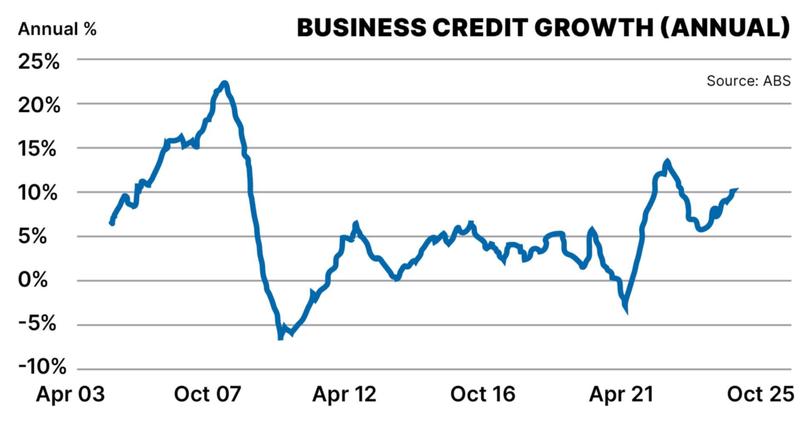JACKSON HEWETT: Three signs of an economic Christmas miracle

It’s nearly Christmas and after a lump of GDP coal got shoved into the country’s economic stocking, I’ve decided ‘tis the season to be merry.
Or as much as we can be.
In hunting around for a Christmas miracle, it doesn’t look all bad. There are some elves busily working away, and some reason for good cheer.
Sign up to The Nightly's newsletters.
Get the first look at the digital newspaper, curated daily stories and breaking headlines delivered to your inbox.
By continuing you agree to our Terms and Privacy Policy.Santa comes in the form of Judo Bank economic adviser Warren Hogan. He is surprisingly optimistic amongst the doom and gloom of Wednesday’s GDP figures and actually thinks there might be a cyclical upswing next year.
Australian Institute of Company Director’s economist Mark Thirlwell also says there is some room for optimism, particularly as GDP figures are backward looking and may not be capturing more recent positive news.
Here are three reasons not to drown your sorrows in the Christmas sherry.
Consumers are starting to spend
The unemployment figures are as good as they’ve ever been, Hogan says with the data suggesting that “there are green shoots of a recovery in consumption.”
Retailers have been reporting a better-than-expected Black Friday period, and while the number are climbing off a low base, they are on the up.
That consumer sentiment tracks with what surveys of confidence have been showing, says Thirlwell.
He points to the Westpac-Melbourne Institute Index of consumer confidence which rose by more than six per cent in October and another five per cent in November, rebounding to levels not seen since late 2022. “That suggests households are feeling better,” Thirlwell says.
There are three elements at play.
First, the stage three tax cuts have been trickling through, with overall tax paid falling by four per cent in September, while the energy rebates have been going into consumers’ pockets, even if the figures still show up on the Government’s account.
Second, wages are continuing to rise, albeit moderately, while inflation is slowing down. Real wages (wages minus inflation) have grown for three straight quarters as demand for workers remains high.
“Consumers are spending a bit more in Q4. These are the strongest employment numbers this economy has ever received, and that will be spent, whether the jobs are NDIS or construction workers,” Hogan says.
Online payments platform Airwallex is seeing signs of optimism. According to Airwallex’s Digital Economy Index, ecommerce sales started 2024 down nearly 37 per cent on 2023, yet have turned around to be up by 16 per cent year on year.
Airwallex head of enterprise, ANZ Huw Griffiths said it has been a remarkable turnaround.
“Confidence is at a high compared to previously in the year,” he said. “It taking place across lots of categories and verticals with online retail performing really well, although we know customers are doing a lot of comparison shopping. And the fact we are seeing more overseas travel is an indication of confidence returning.”
Thirlwell says we should be past the peak of the interest rate cycle and that the other big thing that may swing consumers’ way is mortgage relief. In June last year, household mortgage costs doubled as borrowers flipped from fixed to variable loans. It is still the biggest contributor to employee households’ living costs, according to the ABS but mortgage inflation has fallen from 100 per cent last year to 19 per cent and is heading lower. While the forecast for a cut in the official cash rate has been pushed out, banks have become more competitive on pricing.
“As rates start to fall, the big ratchet-up in interest rate effects will come off,” Thirlwell says.
The recent GDP figures showed a lift in savings, suggesting that wary consumers are getting in front of expenses while building up a bit of a buffer. But remember, savings are a form of deferred consumption.
Business is looking more confident
The headline numbers for industry looked bad, but particularly so if mining is counted. That industry is wholly affected by international forces so we have to look beyond the aggregate.

The Australian Industry Group’s monthly index for industrial activity is starting to point in the right direction.
While still in contraction, the downward trend that started with COVID and continued with rate rises in 2022 has been turning up since July.
Activity and new orders strengthened in November, and there was a very strong improvement for the construction and business services sectors. Business credit continues to grow, up nearly 8 per cent over the year, suggesting confidence in the sector, with the manufacturing sector a standout in terms of borrowing with good signs of life after a heavy hit, Hogan says.
That capital expenditure is desperately needed after a long period of underinvestment.
“Core capex, which is investment in plant, equipment and machinery was flat between the GFC and COVID, and that’s why we now have productivity problems and have had tepid growth,” Hogan says.

“Capex is rising to this quarter, it was up in quarter and expectations are that it’s going to grow another 3 per cent. It drives future productivity, and it reflects confidence from business in the future economy.”
Compared to peers, Australia is... middling
A report released overnight by the OECD shows Australia is not alone in its current malaise. Titled ‘Resilience in uncertain times’ the report sees just 1.9 per cent growth next year for member countries. That is their forecast for Australia’s growth next year as well and that’s better than Canada, Japan or the eurozone.
Inflation in the OECD is running at four per cent, compared to our underlying rate of 3.5 per cent and inflation is forecast to fall further globally next year to 3.8 per cent.
The challenges Australia faces are also not unique. The issue is felt across the OECD, with ageing populations and declining productivity due a lack of skilled workers.
“Ambitious structural reforms are necessary to reinvigorate weak potential output growth. The policy mix needs to include efforts to enhance education and skills development ,” the OECD writes in a policy prescription that could be right out of Treasurer Jim Chalmers election pitch.
Or Angus Taylor’s.
After all, the OECD President is former Coalition finance minister Mathias Cormann who had this to say.
“To boost productivity and the foundations for growth, we must enhance education and skills development efforts, undo overly stringent constraints to business investment and successfully tackle the structural increase in labour shortages.”
It’s the kind of boiler-plate sentiment that wouldn’t be out of place in a Christmas card.
It also happens to be on the country’s New Year resolution list, but perhaps we’ll get started on that after a couple of glasses of sherry.

